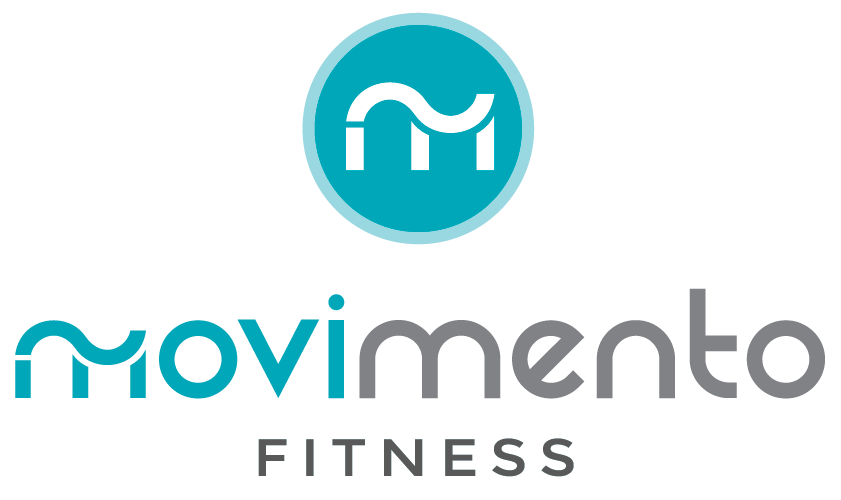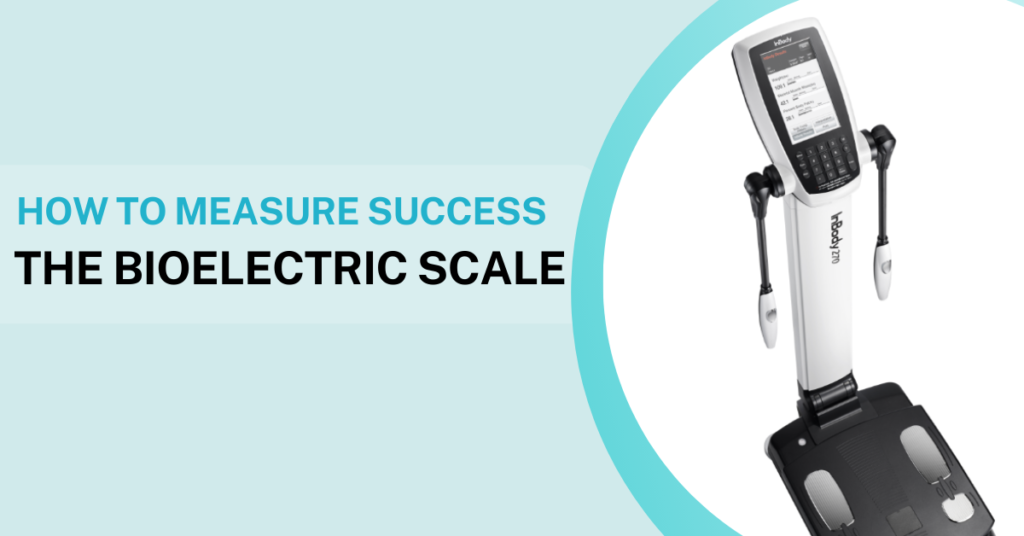Your health and fitness journey is unique to you. Whether you are just getting started and your goal is to simply move your body or if you have specific targets in mind regarding how your body looks, we all have different milestones we want to reach. And because not everyone has the same goals, fitness history, and starting point, that means we also have to measure success dynamically as well.
For many people, the goal of losing weight is often their initial motivation to start getting more active. And while weight can be partially indicative of health, it doesn’t tell the whole story. Regardless of what the beauty industry wants you to believe, the number on the scale does not define your worth or even tell you if you’re “skinny,” “fat,” or even “fit.”
You’ve probably seen this image floating around the internet:
It’s powerful. It’s a visual representation that proves it: The number of pounds you weigh doesn’t tell the whole story.
Still, we are firm believers in measuring success. You need to track your progress to see how much power you have. To see what you did and inspire you to challenge yourself to what else you can do to give yourself the healthier lifestyle you’ve been wishing for. That’s why in our facility, we go beyond just the traditional scale.
Here at Movimento Fitness, we include Inbody scans throughout your training program to track your progress.
In addition to tracking your goals and fitness level as you progress through your exercise program, we also do bioelectric impedance analysis using an Inbody machine.
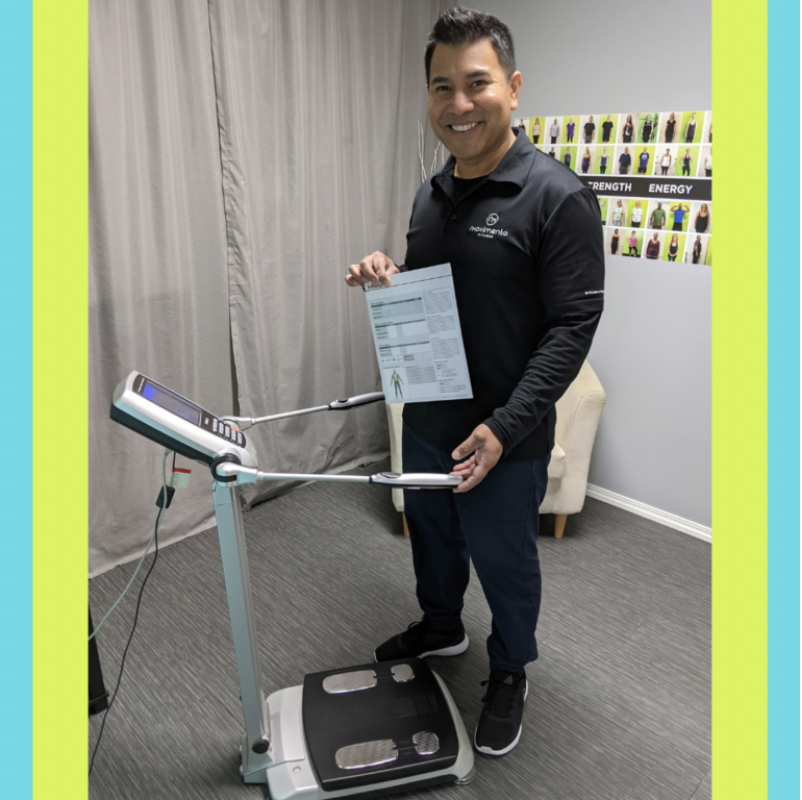
A bioelectric impedance analysis, or bioelectric scale, measures body composition. It pulses LIGHT electrical currents through the body and measures how fast the pulses return back to the machine. Body fat causes greater resistance than a fat-free mass, so it slows the rate that the current travels. The scale then determines the body fat percentage of the body, based on how fast the current returns to the machine.
These scales require two points of contact on the skin. You stand on the machine with your bare feet and hold onto the machine’s handles. This creates a closed circuit between you and the machine. The current will travel up through your feet to your hands and can measure the body composition of each side of your body this way.
These devices are very safe. The electric pulse that it uses to measure body fat is low—so low you cannot even feel it. After about 20 seconds you can step off the machine and it prints a detailed review of your personal body composition and gives you valuable insight into your unique makeup.
What is Body Composition?
Body composition is what you’re made of, literally! It’s a method of breaking down the body into its core components: fat, bone, water, and muscle in the body. When we look at body composition through methods like BIA scanning, we get a more accurate glimpse into your overall health, beyond what the number on the scale can tell you.
It’s important to measure body composition to further target the fitness goals that are unique to you. In the above example, we saw exactly how a body that is 154 can look and be composed very differently.
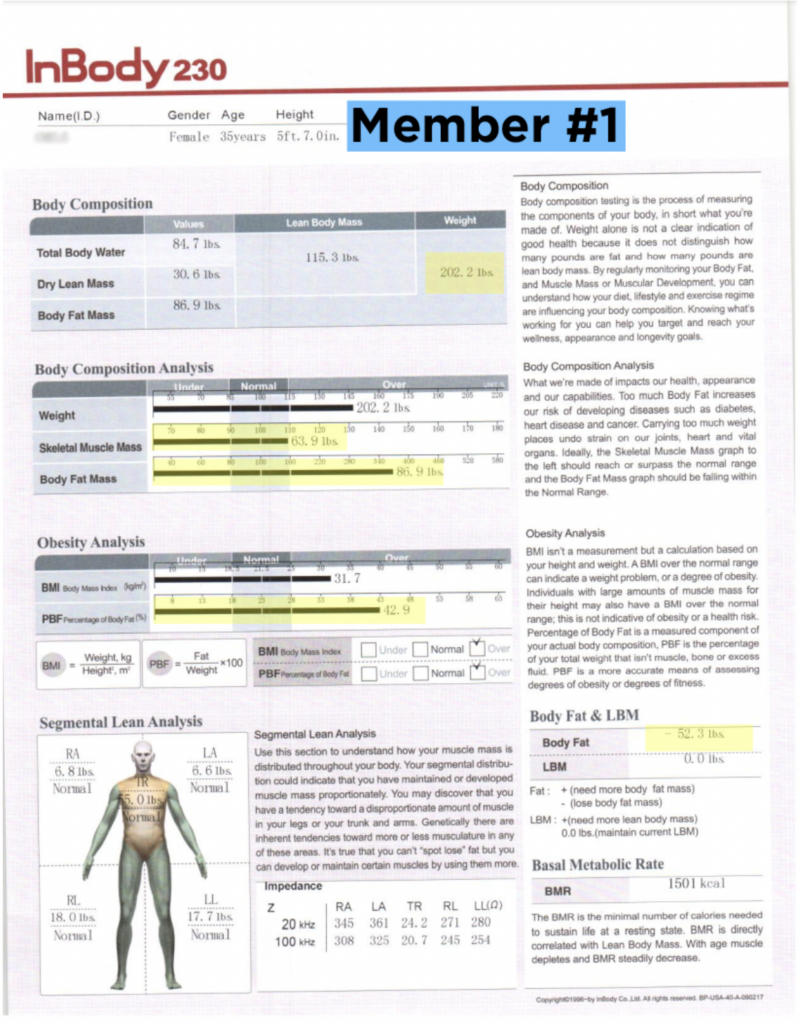
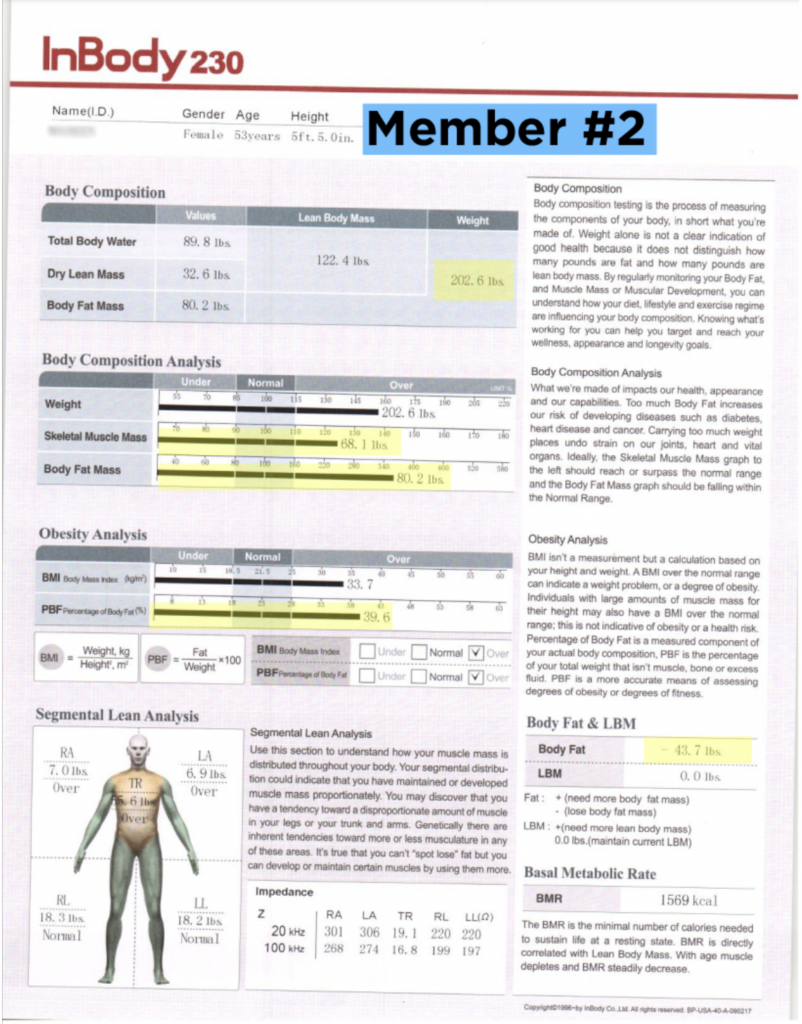
Member #1 at 202 lbs has a lower amount of muscle mass and therefore has a higher Percentage of Body Fat than Member #2 at 202 lbs.
Most people only have the number on the scale and a BMI or Body Mass Index number from their doctor to guide them when starting on a journey to improve their health. But unfortunately, both of these numbers do not show you the full picture.
Why Can the Traditional Scale Leave You Discouraged?
You can be making great progress toward a healthier lifestyle and a healthier body but the number on your traditional scale will not move an inch.
For example, these are two Inbody scan sheets from one of our members that we work with here at Movimento, an initial scan when she first started training, and a scan from a progress check-in:
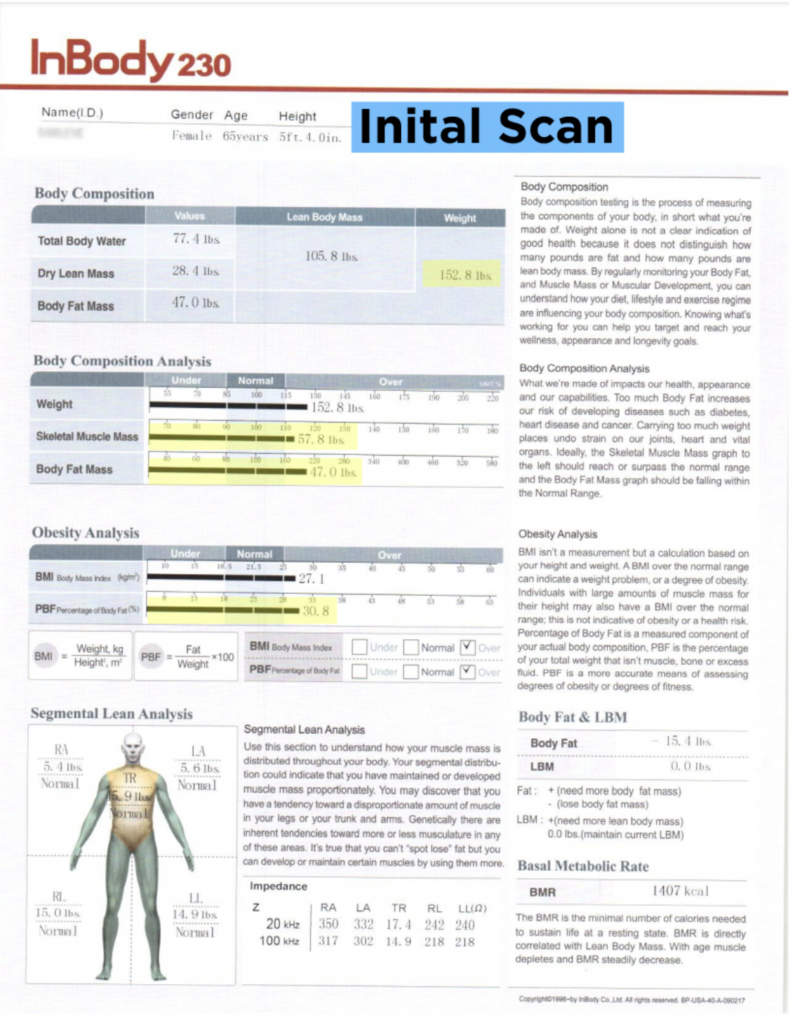

Now if she had JUST been looking at the number on a traditional scale she might have been discouraged or disappointed that her weight on the scale went up.
BUT… looking into her Inbody Scan
=> She actually gained 3lbs of lean muscle
=> And lost almost 4lbs of body fat
=> Plus she dropped her percentage of body fat by 2.6% bringing her back down into the normal range
So even though her weight stayed the same she was making big changes. Her clothing was fitting better, she was feeling great, and she was getting stronger. She felt like her body was changing – and only the Inbody could give her that confirmation that all her hard work was indeed paying off!
Which leads us to…
Why Can BMI be inaccurate?
In the medical field, doctors rely on numbers and stats to make recommendations and predict health outcomes. One method to do this is by measuring your Body Mass Index (BMI). This takes your weight and height and scores you on an agreed-upon chart that either says you are under, over, or average. They then use this score to determine their recommendations.
Despite its widespread use, BMI has limitations and can be a poor tool for tracking weight change because you cannot use BMI to determine the amount of your weight that comes from fat or muscle.
As a result, someone with a lot of muscle mass and a low body fat percentage can still have a high BMI.
In contrast, someone that is thin, that has what is considered a healthy BMI can actually have low muscle mass and a high body fat percentage. People who are thin can have an acceptable amount of subcutaneous fat, the type that is stored just under the skin, but have an excessive amount of visceral fat which can lead to elevated health risks. Visceral fat cannot be measured with BMI or a traditional scale so many people in this scenario are often completely unaware of their potential health risks.
For example, this member when she first came to us had a BMI in the normal range but had a below-normal range of skeletal muscle mass and a higher than normal percentage of body fat:
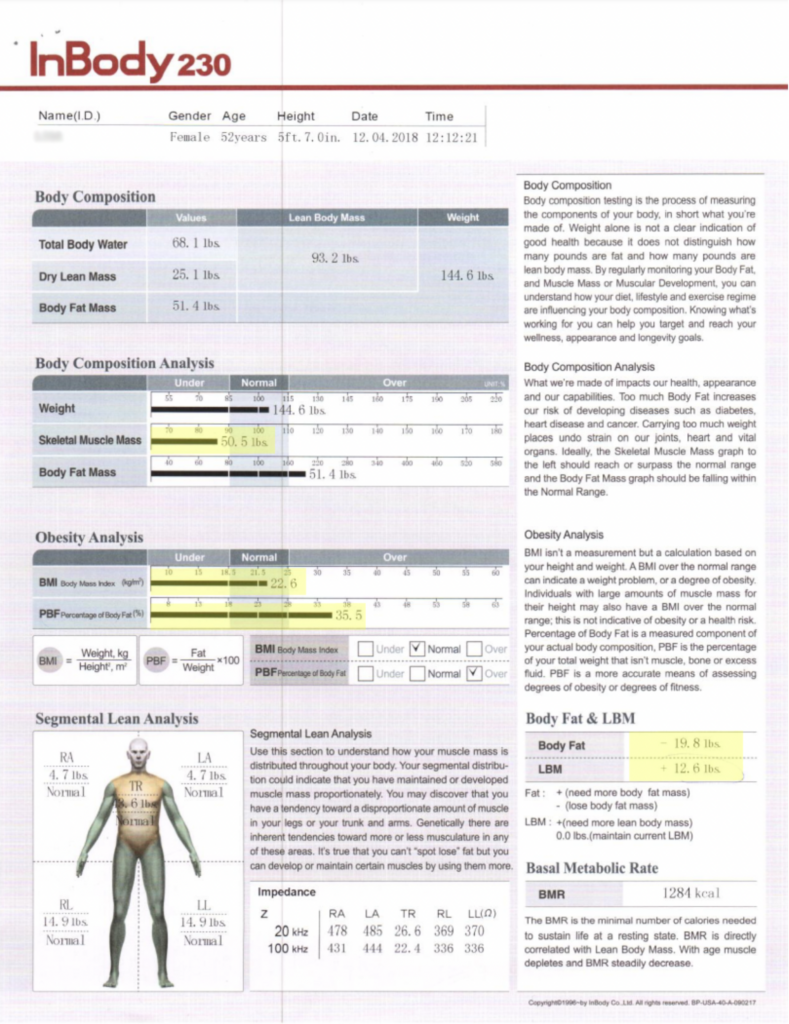
The BMI scale oversimplifies health risks and ignores factors that may contribute positively to your health.
This is why when we do our Inbody scans, we look at your body composition, including your body fat percentage AND your skeletal muscle mass.
What is Skeletal muscle mass?
Skeletal Muscle Mass is important for mobility, posture, and strong immunity for long-term health. These are the muscles that connect to your bones and allow you to move! These muscles are voluntary, meaning you control how they work. For example, you choose to move your leg, where you don’t choose how your heart pumps (this would be a cardiac muscle).
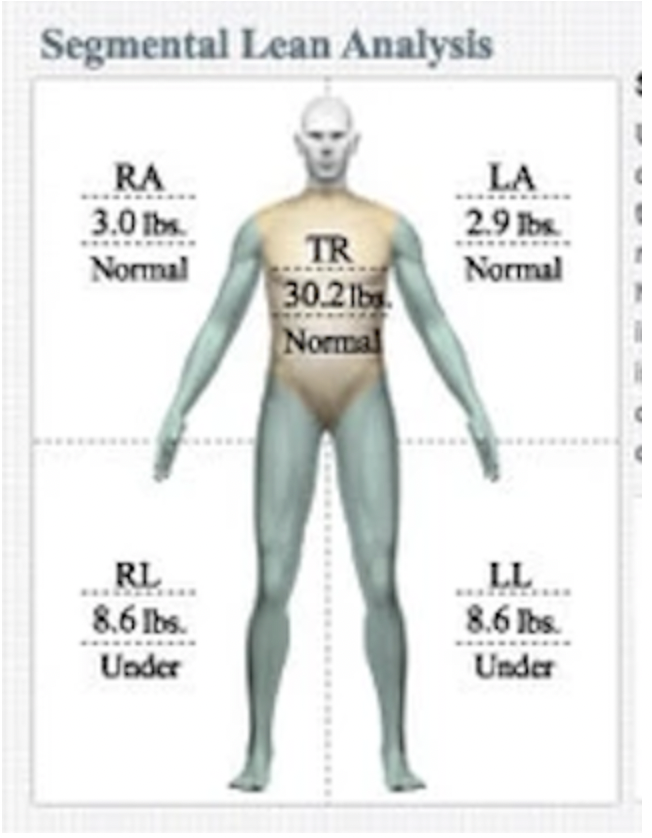
Skeletal muscle mass serves many functions including:
- Expanding and contracting your chest cavity to help you breathe better
- Maintaining body posture
- Moving bones in different parts of your body (like walking, exercising, stretching, etc.)
- Protecting joints and holding them in place
Ideally, your skeletal muscle mass comprises about 30-40% of your total body mass (weight), though that may change depending on your age. When we use our bioelectric Inbody scale, we take a look at your total body composition, including exactly how much skeletal muscle mass you have in each of your body’s segments, so you can focus on specific areas to build more muscle and ensure your whole body is balanced.
The more skeletal muscle mass you have the better! This lean body mass helps you:
- reduce the liklihood of obesity – skeletal or “lean muscle mass” is associated with your metabolic rate (the amount of calories you get at rest. The more skeletal muscle mass, the higher the metabolism!
- defend against disease and illness – when your immune system is kicked into high gear, it will look for protein, which is found in your skeletal muscle mass!
- build stronger bones – building sketal muscle around your bones protects them against the effects of conditions like osteoporosis. The more the bone is supported, the stronger it is!
- protect against insulin resistence –
It’s extremely important to track skeletal muscle mass, especially as we age. As we age, we lose skeletal muscle mass, which can cause pain, loss of mobility, balance problems, falls, and more! This process of losing skeletal muscle mass is called sarcopenia, and while aging is a factor, it can be combated through the right exercise!
Let’s take an example from a 62-year-old member that recently joined us for our 6 week Stronger For Longer program:
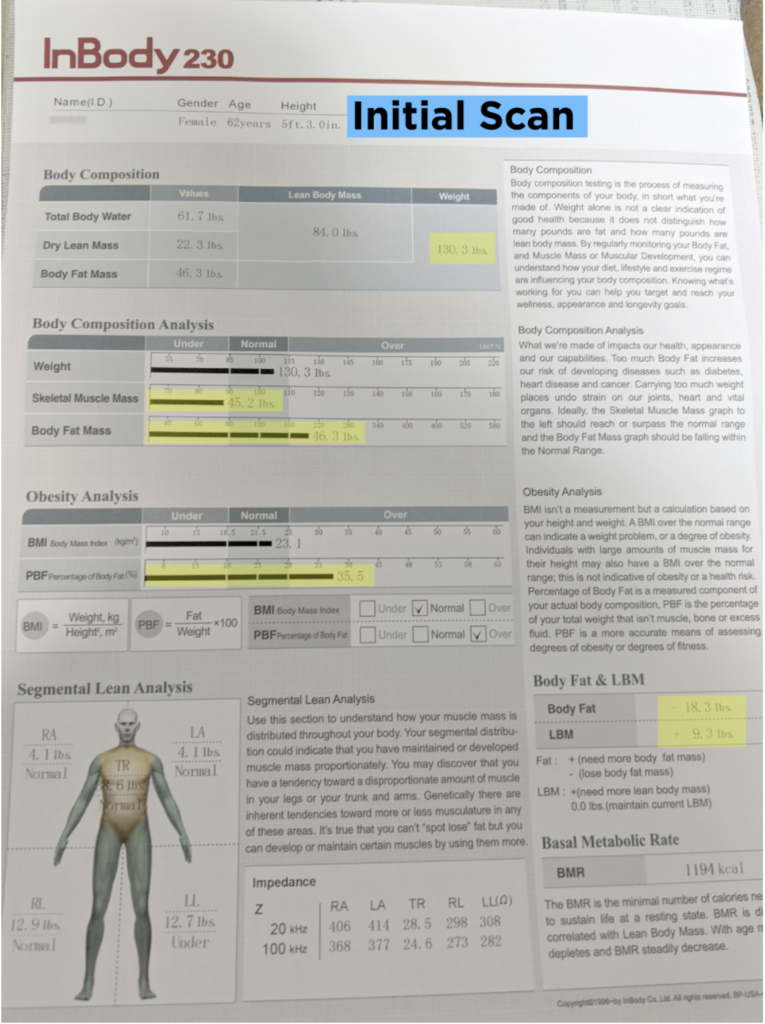
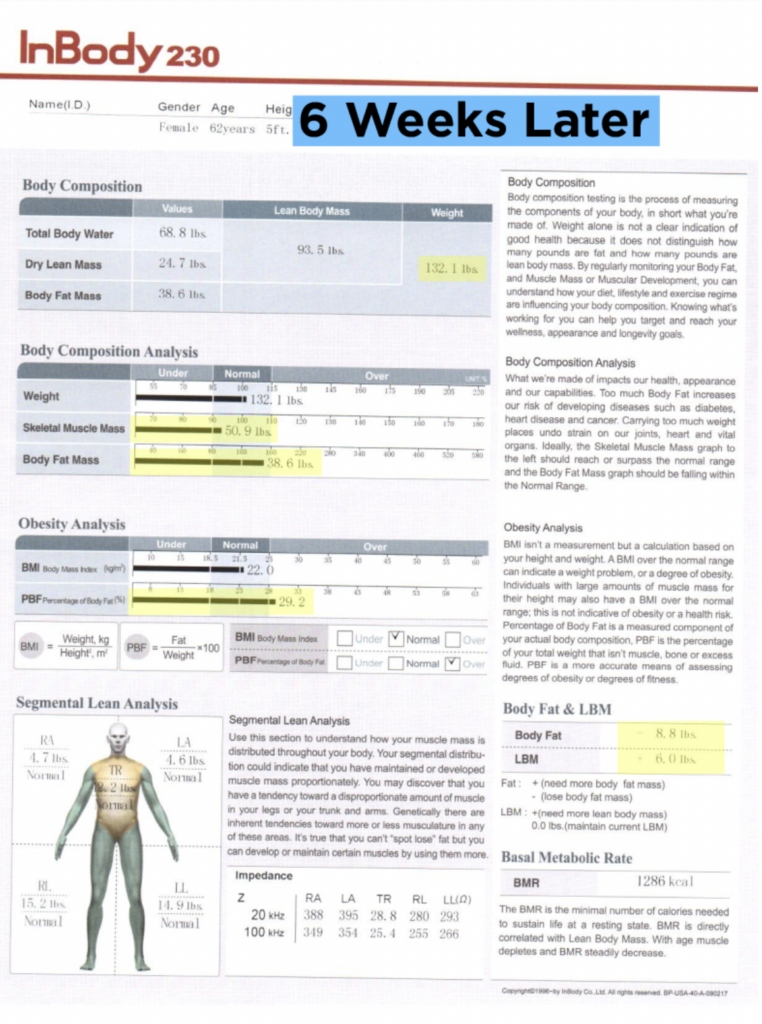
=> In the first scan she weighed 130.3lbs. In her second scan she weighed 132.1 lbs
Again, her weight on the scale went up!
BUT… looking into her Inbody Scan:
=> She actually lost 7.7lbs of body fat
=> Dropped her percentage of body fat by 6.3%
=> And increased her lean muscle by 5.7lbs
This huge shift in her body composition in just 6 weeks put her skeletal muscle mass back into the normal range – meaning that she is building strength and reversing age related muscle mass loss. Plus, she brought her body fat percentage down significantly.
Another important reason to use Inbody Scans is to make sure that muscle mass is increasing (or at least saying the same) if you are working to lose weight. Sometimes when you lose weight, say by following a restrictive diet, you will lose body fat but ALSO lose muscle. By using Inbody scans we can make sure that your training program and your nutrition are working together to build lean muscle WHILE losing body fat.
Let’s look at another example 63 year old member that recently joined us for our 6 week Stronger For Longer program:
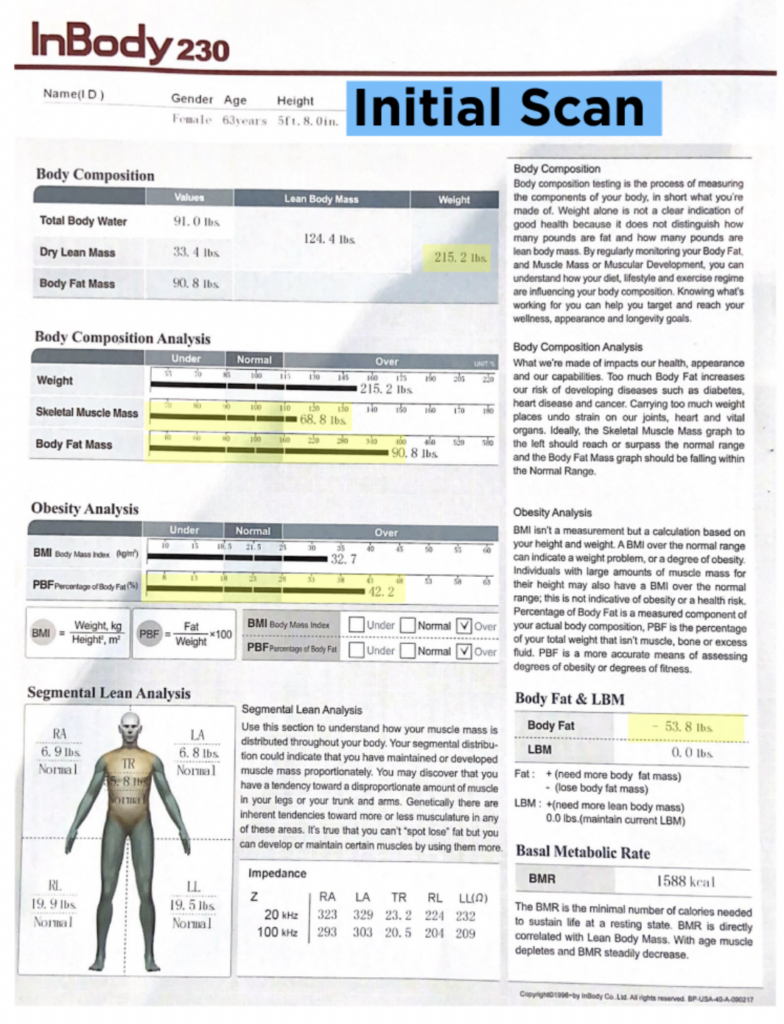
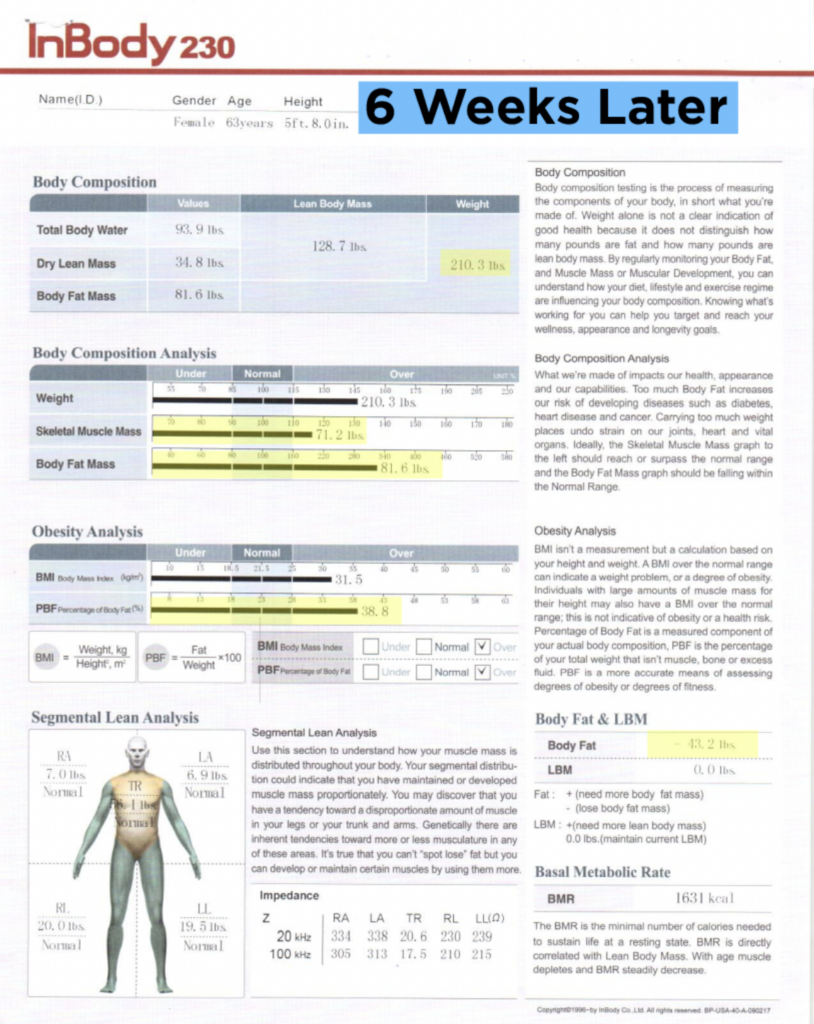
=> This member also made some significant changes to her body composition in just 6 weeks
=> It is important to see that she lost 9.2 lbs of strictly body fat while increasing her skeletal muscle mass by 2.4lbs
=> Which means that she was able to effectively lose body fat while still building that lean muscle that gives so many benefits
Understanding Your Own Inbody sheet
When we do Inbody scans, you’ll receive a copy of your Inbody sheet that contains a lot of information about your body composition.
The sheet will look like this:
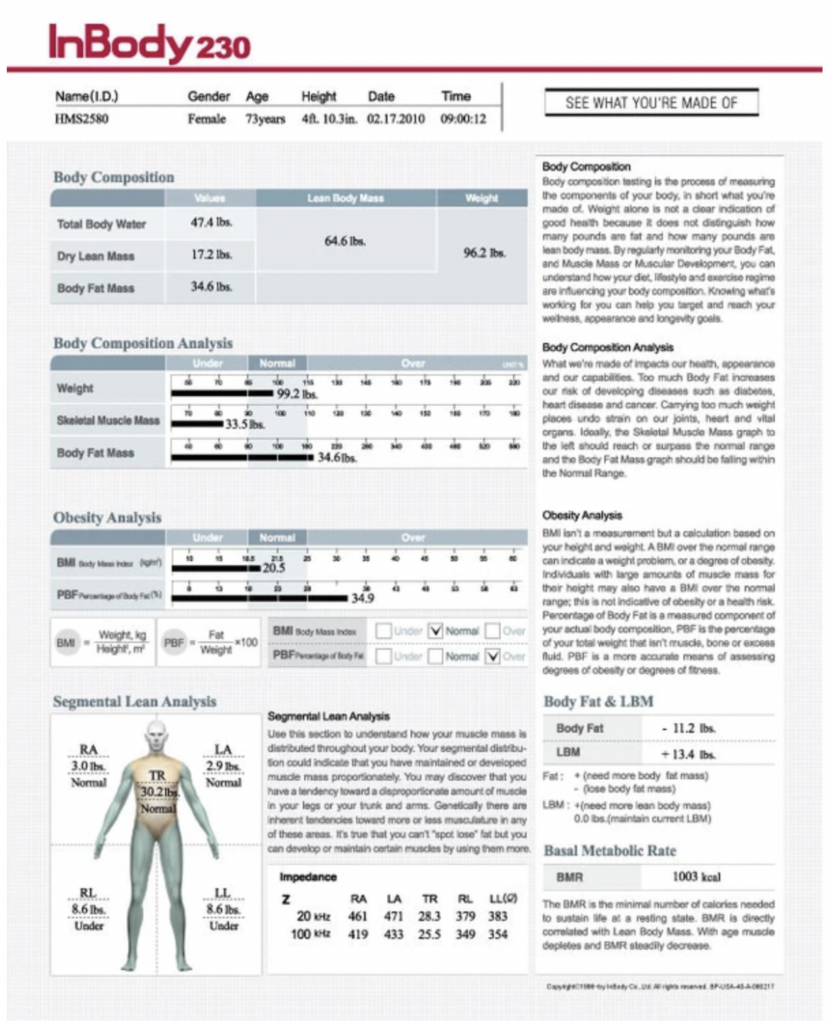
Here’s a breakdown of what each category means:
Body Composition
Total Body Water – This is the amount of water contained in your tissue, blood, bones, and elsewhere. Body water is an important building block for our cells. Generally, we should have 40-65% body water depending on our age and gender.
Dry Lean Mass – This is the total body mass minus the water and the fat mass. This is pure muscle mass.
Body Fat Mass – This is the total mass of fat that is in your body.
Body Composition Analysis
Weight – This is the total mass of your body, in pounds. This is a traditional scale reading.
Skeletal Muscle Mass – These are the muscles that connect your bones and allow you to move.
Body Fat Mass – This is the total mass of fat that is in your body.
Obesity Analysis
BMI – This is a person’s weight in kilograms divided by the square of height in meters.
PBF (percentage of body fat) – This is the total mass of fat divided by total body mass, multiplied by 100.
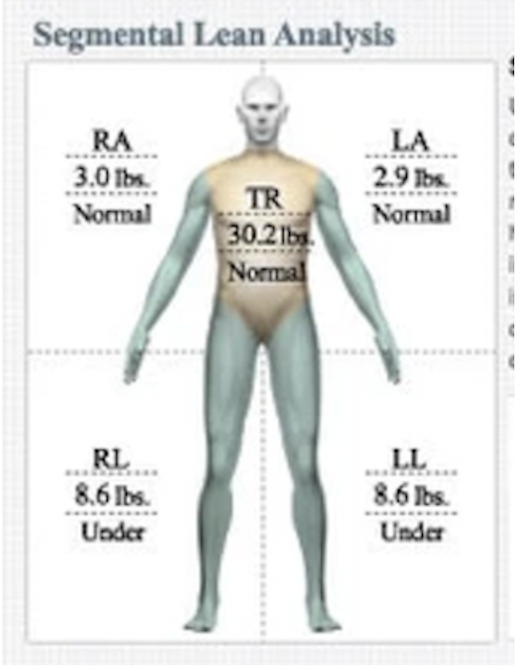
Segmental Lean Analysis
This section of the scan is to help you understand how your mass is distributed. Some may carry more weight in their upper half or lower half. Some may have more muscle mass in one side of their body as they favour that side. Looking at this analysis allows you to see where you can work to balance out your muscle and ensure both sides of your body are supported.
Your Inbody sheet will also contain information about how to apply these stats to your goals. For example, if you have a higher body fat percentage, working on your lean muscle mass may bring this down.
Basal Metabolic Rate
This is the minimum number of calories you need to sustain life at a resting state. It’s correlated with your lean body mass. As you age, your metabolic rate steadily decreases, so it’s important to note the MINIMUM amount of calories you need in the tank to keep your engine running.
What your graphs can look like
On the back of your Inbody sheet, you will find more information about your results and how to read them. It might look something like this:
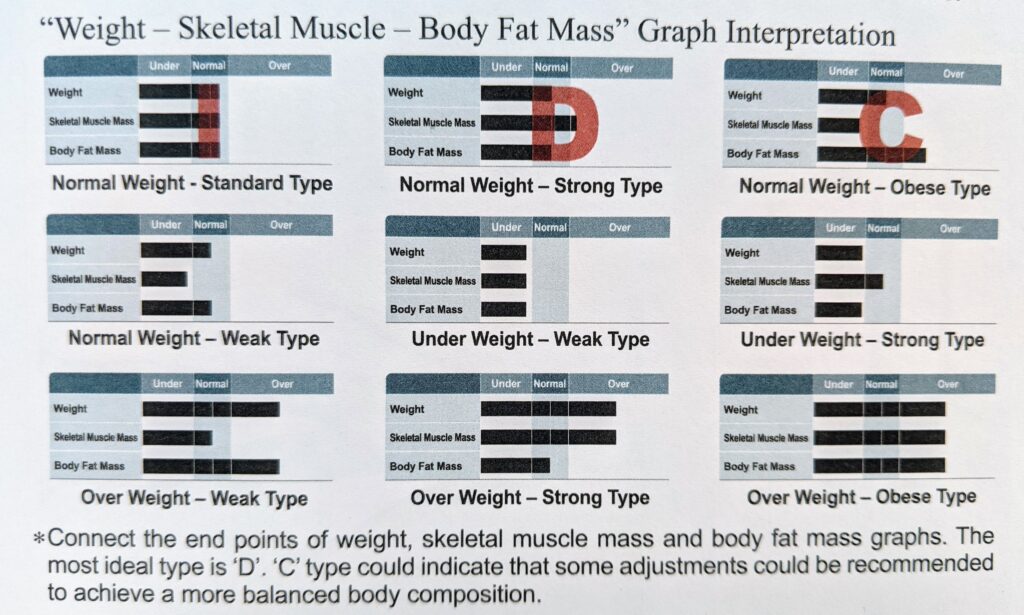
The most ideal shape for your graph is “D”. If your graph is a “C” proper training and nutrition can help you move towards an “I” and eventually a “D” graph.
Measuring your success
Every body is different and everyone has different goals. The bioelectric scale is just one way to measure progress, and the reality is: you define success.
Our number one concern helping you see success with the goals YOU want to achieve. We want you to rebuild your relationship with exercise in a way that allows you to see beyond the scale. We want you to be able to do everything that you want to in your life without being held back by your body or your health.
As we move our bodies and strengthen our muscles, our day-to-day activities become easier. We have more energy to do things with the people we love. The numbers on the scale are just a bonus!
If you are not yet training with us our 6 Week New Member Program – Stronger For Longer – is the best place to start. The 6 week program includes customized training, nutritional guidance and assessments with Inbody scans to show you all of the progress you are making!
